
Belle Meade Plantation, now officially titled Belle Meade Historic Site and Winery, is a historic farm established in 1807 in Nashville, Tennessee, built, owned, and controlled by five generations of the Harding-Jackson family for nearly a century. The farm, named "Belle Meade", grew to encompass 5,400 acres (22km2) at its zenith and used a labor force of 136 enslaved workers. The farm's centerpiece was a Greek revival mansion built in 1853. Belle Meade Farm gained a national reputation in the latter half of the 19th century for breeding thoroughbred horse racing stock, notably a celebrated stallion, Iroquois. In the Civil War, when the Union Army took control of Nashville, the mansion was pillaged and looted by soldiers who spent weeks quartered there; the owner was imprisoned. In the aftermath, the plantation recovered, but with greatly reduced capacity. Roughly half of the enslaved persons returned as paid employees after the war and lived in their own homes nearby. After a financial downturn in 1893 and later the death of the owner and his heir, the estate was dismantled and sold in parcels in 1906.
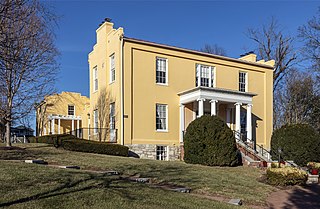
Beall-Air, also known as the Colonel Lewis William Washington House, is a two-story stuccoed brick house in classical revival style near Halltown, West Virginia. It was the home of Colonel Lewis William Washington, great-great nephew of President George Washington and hostage in John Brown's raid on Harpers Ferry, West Virginia.
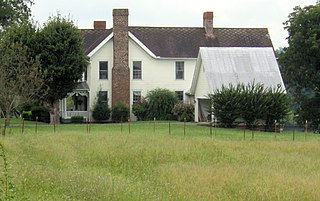
Brabson's Ferry Plantation is a Pioneer Century farm and former antebellum plantation near the U.S. city of Sevierville, Tennessee. Located at what was once a strategic crossing of the French Broad River, by 1860 the plantation had become one of the largest in East Tennessee, and one of the few in the region that rivalled the large plantations of the Deep South in size and influence. The farm remains in operation, and several of its historic structures— including two plantation houses and an 18th-century plank house— have been added to the National Register of Historic Places.
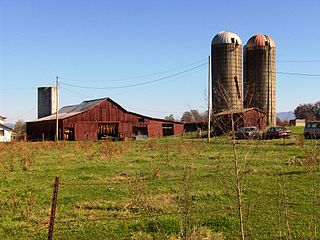
The Earnest Farms Historic District is a historic district consisting of four historic farms and associated structures near the community of Chuckey in Greene County, Tennessee, United States. The farms include the Elmwood Farm, the Broyles Farm, the Crum Farm, and the Jim Earnest Farm, all of which were initially developed by early pioneer Henry Earnest (1732–1809) and his descendants in the late-18th and 19th centuries. The district includes the Ebenezer Methodist Church, which is home to the oldest Methodist congregation in Tennessee, and the Earnest Fort House, which is one of the oldest houses in the state. Elmwood Farm has been designated a century farm and is one of the oldest farms in Tennessee, having been cultivated continuously since 1777.

Walnut Valley is a historic plantation house and archaeological site located near Highgate, Surry County, Virginia. The property includes a plantation house, a frame slave quarter (1816), a frame kitchen (1816), seven contributing 19th- and 20th-century agricultural and domestic outbuildings and structures, and an archaeological site. The house is a 1+1⁄2-story, four-bay, double-pile, side-gabled frame house on a brick foundation. It measures 40 feet, 4 inches, by 30 feet, 5 inches and features Federal style decorative elements. The one-story, two-bay frame slave quarter measures 14 feet by 16 feet, and is clad in weatherboard. The contributing outbuildings include a late-19th century storehouse and a granary, well house, silo, and three chicken houses. The property was conveyed to the Commonwealth of Virginia for the Virginia Department of Conservation and Recreation on January 14, 2004. It is now contained within Chippokes Plantation State Park.

Dr. Isham G. Bailey House, also known as Cedar Lane Farm, is a historic cottage in Lamar, Mississippi, United States.

The Hofwyl-Broadfield Plantation was a plantation on the Altamaha River, in Glynn County, Georgia, United States. Operated as a forced-labor farm using enslaved peoples until 1865, it produced rice from 1800 until 1915, when growing rice became unprofitable. Then it was primarily a dairy farm until 1942. Since 1976, the Georgia Department of Natural Resources has managed it as Hofwyl-Broadfield Plantation State Historic Site.

Beech Grove is a historic mansion in Nashville, Tennessee. Built as a log house circa 1850, it was a Southern plantation with African slaves in the Antebellum era. In the 1910s, it became a livestock farm.

Skipwith Hall, also known as Skipwith Place, Oakwood Farm, Skipwith Harlan Hill, and Oakwood Hall, is a former plantation and plantation house located in Maury County, Tennessee. It was initially built by Edward Brinley Littlefield and Cornelia Lott Skipwith as their residence.
Mark Robertson Cockrill (1788-1872) was an American cattleman, horse breeder and planter. He was the owner of a large farm in Davidson County, Tennessee and a cotton plantation with 300 slaves in Mississippi. He won many prizes for his sheep-rearing both nationally and internationally, and he became known as the "Wool King of the World". He was a multi-millionaire prior to the American Civil War, and he loaned gold to the Confederate States of America during the war.
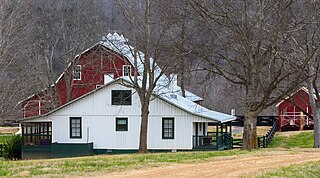
Dozier Farm, also known as Cliffview Farm, is a historic mansion in Nashville, Tennessee, U.S..

The Alexander Ewing House is a historic mansion in Nashville, Tennessee, U.S. The two-story plantation home was built in 1821 in the Federal architecture style for Alexander Ewing. It is constructed of brick with a stone foundation and a gable roof. Both the north and south side elevations feature a pair of chimneys connected by a parapet wall. The house has been listed on the National Register of Historic Places since November 25, 1980.
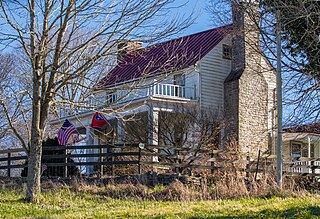
The Prewitt-Amis-Finney House, also known as Turnhill Farm, is a historic three-story house in Culleoka, Tennessee, U.S.. Built for the slaveholding Prewett family in 1810, it was established as a mule farm. It is located a few miles away from Columbia, and it overlooks Fountain Creek.
The Maple Dean Farm is a historic farmhouse in Shelbyville, Tennessee, U.S.. Built in 1886 on a farm established in 1819, it was designed in the Eastlake architectural style. It became a century farm in 1976, and it was listed on the National Register of Historic Places in 1976.

Ewing Farm is a historic farmhouse three miles away from Lewisburg, Tennessee, US.

The Logan Henderson Farm, also known as Farmington, is a historic farm house in Murfreesboro, Tennessee, U.S.. Built as a slave plantation in the Antebellum South, it later became a dairy and cattle farm. It is now a horse farm.

Murray Farm is a historic farmhouse in Readyville, Tennessee, U.S..
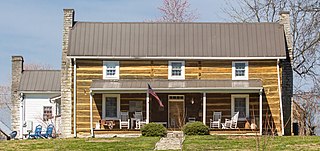
The Brown-Chenault House, also known as Campbell Farm, is a historic house in Castalian Springs, Tennessee, United States.
Greenfield, also known as the David Chenault Home, is a historic farmhouse in Castalian Springs, Tennessee, U.S..

The Terrell-Sadler House near Eatonton, Georgia was listed on the National Register of Historic Places in 2000. It is located at 122 Harmony Road.


















